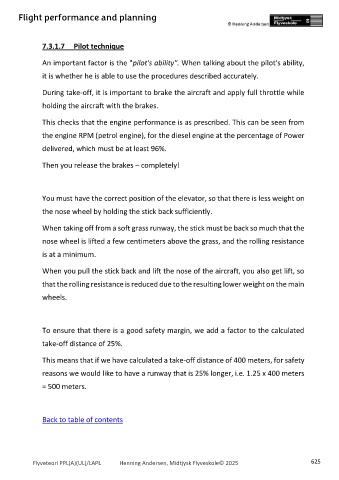Page 625 - PPL-engelsk 2025
P. 625
Flight performance and planning
7.3.1.7 Pilot technique
An important factor is the "pilot's ability". When talking about the pilot's ability,
it is whether he is able to use the procedures described accurately.
During take-off, it is important to brake the aircraft and apply full throttle while
holding the aircraft with the brakes.
This checks that the engine performance is as prescribed. This can be seen from
the engine RPM (petrol engine), for the diesel engine at the percentage of Power
delivered, which must be at least 96%.
Then you release the brakes – completely!
You must have the correct position of the elevator, so that there is less weight on
the nose wheel by holding the stick back sufficiently.
When taking off from a soft grass runway, the stick must be back so much that the
nose wheel is lifted a few centimeters above the grass, and the rolling resistance
is at a minimum.
When you pull the stick back and lift the nose of the aircraft, you also get lift, so
that the rolling resistance is reduced due to the resulting lower weight on the main
wheels.
To ensure that there is a good safety margin, we add a factor to the calculated
take-off distance of 25%.
This means that if we have calculated a take-off distance of 400 meters, for safety
reasons we would like to have a runway that is 25% longer, i.e. 1.25 x 400 meters
= 500 meters.
Back to table of contents
Flyveteori PPL(A)(UL)/LAPL Henning Andersen, Midtjysk Flyveskole© 2025 625

